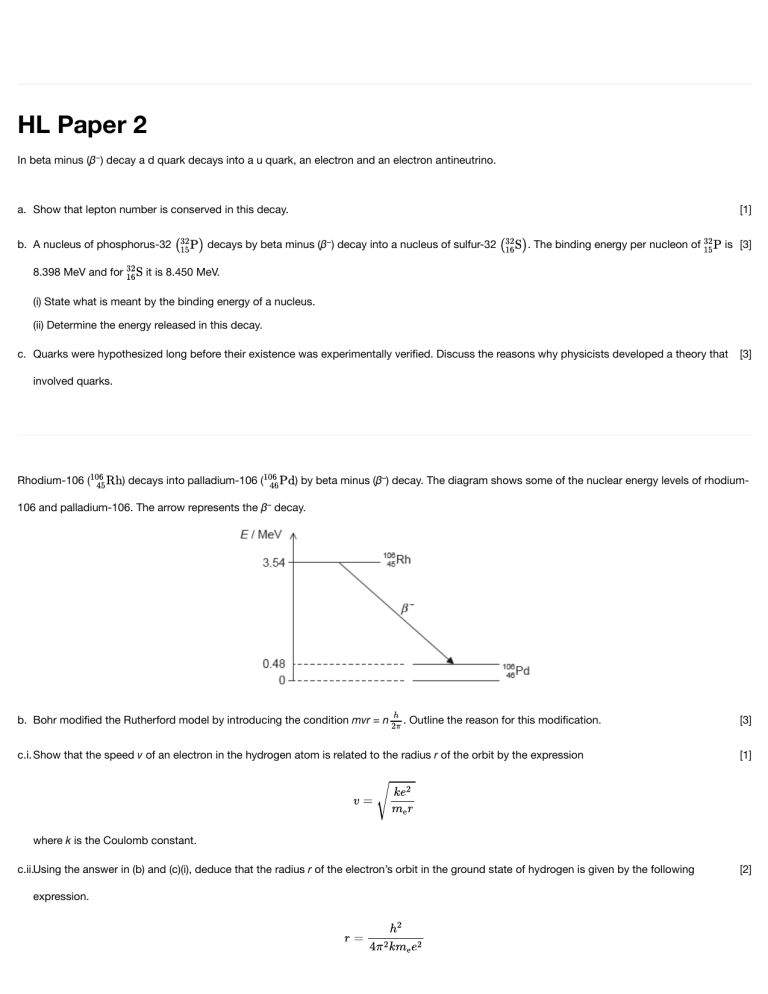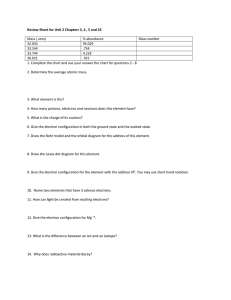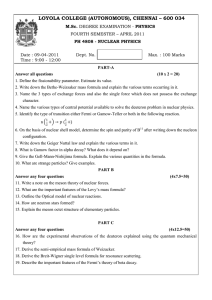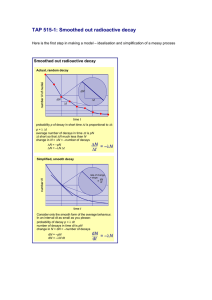
HL Paper 2 In beta minus (β−) decay a d quark decays into a u quark, an electron and an electron antineutrino. a. Show that lepton number is conserved in this decay. b. A nucleus of phosphorus-32 8.398 MeV and for [1] decays by beta minus (β−) decay into a nucleus of sulfur-32 . The binding energy per nucleon of is [3] it is 8.450 MeV. (i) State what is meant by the binding energy of a nucleus. (ii) Determine the energy released in this decay. c. Quarks were hypothesized long before their existence was experimentally verified. Discuss the reasons why physicists developed a theory that [3] involved quarks. Rhodium-106 ( ) decays into palladium-106 ( ) by beta minus (β–) decay. The diagram shows some of the nuclear energy levels of rhodium- 106 and palladium-106. The arrow represents the β– decay. b. Bohr modified the Rutherford model by introducing the condition mvr = n . Outline the reason for this modification. c.i. Show that the speed v of an electron in the hydrogen atom is related to the radius r of the orbit by the expression [3] [1] where k is the Coulomb constant. c.ii.Using the answer in (b) and (c)(i), deduce that the radius r of the electron’s orbit in the ground state of hydrogen is given by the following expression. [2] c.iii.Calculate the electron’s orbital radius in (c)(ii). [1] d.i. Explain what may be deduced about the energy of the electron in the β– decay. [3] d.ii.Suggest why the β– decay is followed by the emission of a gamma ray photon. [1] d.iii.Calculate the wavelength of the gamma ray photon in (d)(ii). [2] This question is about nuclear reactions. A reaction that takes place in the core of a particular nuclear reactor is as shown. In the nuclear reactor, fissions take place every second. Each fission gives rise to 200 MeV of energy that is available for conversion to electrical energy. The overall efficiency of the nuclear power station is 32%. a.i. State the nature of X. [1] a.ii.State one form of energy that is instantaneously released in the reaction. [1] b.i. Determine the mass of U-235 that undergoes fission in the reactor every day. [3] b.ii.Calculate the power output of the nuclear power station. [2] c. In addition to the U-235, the nuclear reactor contains graphite that acts as a moderator. Explain the function of the moderator. [3] d. Outline how energy released in the nuclear reactor is transformed to electrical energy. [3] This question is in two parts. Part 1 is about electric fields and radioactive decay. Part 2 is about waves. Part 1 Electric fields and radioactive decay An ionization chamber is a device which can be used to detect charged particles. The charged particles enter the chamber through a thin window. They then ionize the air between the parallel metal plates. A high potential difference across the plates creates an electric field that causes the ions to move towards the plates. Charge now flows around the circuit and a current is detected by the sensitive ammeter. The separation of the plates d is 12 mm and the potential difference between the plates is 5.2 kV. An ionized air molecule M with charge is produced when a charged particle collides with an air molecule. Radium-226 decays into an isotope of radon (Rn) by the emission of an alpha particle and a gamma-ray photon. The alpha particle may be detected using the ionization chamber but the gamma-ray photon is unlikely to be detected. a. On the diagram, draw the shape of the electric field between the plates. [2] b.i. Calculate the electric field strength between the plates. [1] b.ii.Calculate the force on M. [2] b.iii.Determine the change in the electric potential energy of M as it moves from the positive to the negative plate. [3] c.ii.Construct the nuclear equation for the decay of radium-226. [2] c.iii.Radium-226 has a half-life of 1600 years. Determine the time, in years, it takes for the activity of radium-226 to fall to 5% of its original activity. [3] This question is about nuclear processes. a. Describe what is meant by [4] (i) radioactive decay. (ii) nuclear fusion. b. Tritium is a radioactive nuclide with a half-life of 4500 days. It decays to an isotope of helium. [3] Determine the time taken for 90% of a sample of tritium to decay. c. A nuclide of deuterium and a nuclide of tritium undergo nuclear fusion. The reaction equation for this process is Identify X. This question is about the Rutherford model of the atom. The isotope gold-197 is stable but the isotope gold-199 is not. [1] A nucleus of decays to a nucleus of . State the two particles, other than -photon, emitted in this decay. This question is about binding energy and mass defect. (i) The nuclear mass of the nuclide helium-3 is 3.014931 u. Show that the binding energy per nucleon for the nuclide is about 2.6 MeV. (ii) The binding energy per nucleon for deuterium (iii) The cross on the grid shows the binding energy per nucleon and nucleon number A of the nuclide nickel-62. is 1.11 MeV. Calculate the energy change in the following reaction. On the grid, sketch a graph to show how the average binding energy per nucleon varies with nucleon number A. (iv) State and explain, with reference to your sketch graph, whether energy is released or absorbed in the reaction in (b)(ii). Part 2 Energy levels of the hydrogen atom The diagram represents the three principal spectral lines in the visible region of the spectrum of atomic hydrogen. The electron in the hydrogen atom can only occupy certain allowed energy levels. (i) Outline how the spectral lines provide evidence for the existence of these energy levels. (ii) Determine the difference in energy between the two levels from which electron transitions give rise to the Hα and Hγ spectral lines respectively. Part 3 Atomic energy levels b. Outline how atomic emission spectra provide evidence for the quantization of energy in atoms. [2] c. Consider an electron confined in a one-dimensional “box” of length L. The de Broglie waves associated with the electron are standing waves [3] with wavelengths given by , where n=1, 2, 3, … Show that the energy En of the electron is given by where h is Planck’s constant and me is the mass of the electron. d. An electron is confined in a “box” of length L=1.0×10–10m in the n=1 energy level. Its position as measured from one end of the box is [4] (0.5±0.5)×10–10m. Determine (i) the momentum of the electron. (ii) the uncertainty in the momentum. a. A particular K meson has a quark structure s. State the charge, strangeness and baryon number for this meson. [2] b. The Feynman diagram shows the changes that occur during beta minus (β–) decay. [3] Label the diagram by inserting the four missing particle symbols and the direction of the arrows for the decay particles. d. C-14 decay is used to estimate the age of an old dead tree. The activity of C-14 in the dead tree is determined to have fallen to 21% of its original value. C-14 has a half-life of 5700 years. (i) Explain why the activity of C-14 in the dead tree decreases with time. (ii) Calculate, in years, the age of the dead tree. Give your answer to an appropriate number of significant figures. [4] The first scientists to identify alpha particles by a direct method were Rutherford and Royds. They knew that radium-226 ( ) decays by alpha emission to form a nuclide known as radon (Rn). At the start of the experiment, Rutherford and Royds put 6.2 x 10–4 mol of pure radium-226 in a small closed cylinder A. Cylinder A is fixed in the centre of a larger closed cylinder B. The experiment lasted for 6 days. The decay constant of radium-226 is 1.4 x 10–11 s–1. At the start of the experiment, all the air was removed from cylinder B. The alpha particles combined with electrons as they moved through the wall of cylinder A to form helium gas in cylinder B. a. Write down the nuclear equation for this decay. [2] b.i. Deduce that the activity of the radium-226 is almost constant during the experiment. [2] b.ii.Show that about 3 x 1015 alpha particles are emitted by the radium-226 in 6 days. [3] c.i. The wall of cylinder A is made from glass. Outline why this glass wall had to be very thin. [1] c.ii.The experiment was carried out at a temperature of 18 °C. The volume of cylinder B was 1.3 x 10–5 m3 and the volume of cylinder A was [3] negligible. Calculate the pressure of the helium gas that was collected in cylinder B over the 6 day period. Helium is a monatomic gas. This question is in two parts. Part 1 is about simple harmonic motion (SHM) and waves. Part 2 is about atomic and nuclear energy levels. Part 1 Simple harmonic motion (SHM) and waves Part 2 Atomic and nuclear energy levels a. A particle P moves with simple harmonic motion. [3] (i) State, with reference to the motion of P, what is meant by simple harmonic motion. (ii) State the phase difference between the displacement and the velocity of P. d. The diagram shows four spectral lines in the visible line emission spectrum of atomic hydrogen. [6] (i) Outline how such a spectrum may be obtained in the laboratory. (ii) Explain how such spectra give evidence for the existence of discrete atomic energy levels. e. The energies of the principal energy levels in atomic hydrogen measured in eV are given by the expression [4] where n=1, 2, 3 .......... The visible lines in the spectrum correspond to electron transitions that end at n=2. (i) Calculate the energy of the level corresponding to n=2. (ii) Show that the spectral line of wavelength λ=485nm is the result of an electron transition from n=4. f. The alpha particles and gamma rays produced in radioactive decay have discrete energy spectra. This suggests that nuclei also possess discrete energy levels. However, beta particles produced in radioactive decay have continuous energy spectra. Describe how the existence of the antineutrino accounts for the continuous nature of beta spectra. Part 2 Atomic spectra The diagram shows some of the principal energy levels of atomic hydrogen. The emission line spectrum of atomic hydrogen contains a blue line of wavelength 490nm. (i) Calculate, in eV, the energy of a photon of wavelength 490 nm. (ii) On the diagram above, identify with an arrow, the electron transition that gives rise to the emission line of wavelength 490 nm. [2] The Feynman diagram shows electron capture. Particles can be used in scattering experiments to estimate nuclear sizes. Electron diffraction experiments indicate that the nuclear radius of carbon-12 is 2.7 x 10–15 m. The graph shows the variation of nuclear radius with nucleon number. The nuclear radius of the carbon-12 is shown on the graph. a.i. State and explain the nature of the particle labelled X. [3] b.i. Outline how these experiments are carried out. [2] b.ii.Outline why the particles must be accelerated to high energies in scattering experiments. [3] c. State and explain one example of a scientific analogy. [2] d.i. Determine the radius of the magnesium-24 nucleus. [2] d.ii.Plot the position of magnesium-24 on the graph. [1] d.iii.Draw a line on the graph, to show the variation of nuclear radius with nucleon number. [2] The radioactive nuclide beryllium-10 (Be-10) undergoes beta minus (β–) decay to form a stable boron (B) nuclide. The initial number of nuclei in a pure sample of beryllium-10 is N0. The graph shows how the number of remaining beryllium nuclei in the sample varies with time. An ice sample is moved to a laboratory for analysis. The temperature of the sample is –20 °C. a. Identify the missing information for this decay. [2] b.iii.Beryllium-10 is used to investigate ice samples from Antarctica. A sample of ice initially contains 7.6 × 1011 atoms of beryllium-10. The present [3] activity of the sample is 8.0 × 10−3 Bq. Determine, in years, the age of the sample. c.iv.The temperature in the laboratory is higher than the temperature of the ice sample. Describe one other energy transfer that occurs between the [2] ice sample and the laboratory. Part 2 Radioactivity Radium-224 is a radioactive nuclide that decays to form radon-220. Radon-220 is itself radioactive and undergoes a further decay. The table shows the series of radioactive nuclides that are formed as the decays proceed. The series ends with a stable isotope of lead. f. For the final thallium nuclide, identify the [2] (i) nucleon number. (ii) proton number. g. Radon-220 is a radioactive gas. It is released by rocks such as granite. In some parts of the world, houses are built from materials containing [2] granite. Explain why it is unlikely that radon-220 will build up in sufficient quantity to be harmful in these houses. h. (i) Calculate, in hour−1, the decay constant of lead-212. (ii) In a pure sample of lead-212 at one instant, 8.0 × 10−3 kg of the lead-212 is present. Calculate the mass of lead-212 that remains after a period of 35 hours. (iii) A sample of pure radium begins to decay by the series shown in the table. At one instant, a mass of 8.0 × 10−3 kg of lead-212 is present in the sample. Suggest why, after 35 hours, there will be a greater mass of lead-212 present in the sample than the value you calculated in (h)(ii). [6]






